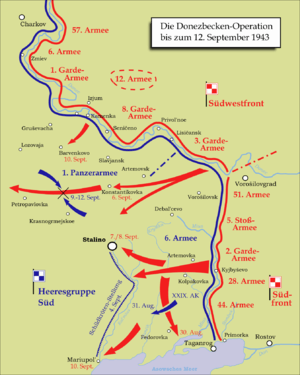Donbass Strategic Offensive (August 1943)
The Donbass Strategic Offensive was a strategic operation of the Red Army on the Eastern Front of World War II with the goal of the liberation the Donbass.
The course of the operation
The Donbass operation began on August 13, 1943 with the offensive of the right wing of the Southwestern Front. These troops forced the Donets river and advancing along the right bank of the river, helped the Steppe Front with the liberation of Kharkiv.
On August 16, the Southern Front troops went on the offensive and broke through the German defense on the Mius River. On August 30, Taganrog was liberated in combination with a naval operation. The XXIX Army Corps was encircled but succeeded to break out, be it with heavy casualties.
As Army Group South was threatened with dismemberment and destruction, Hitler finally allowed Manstein to withdraw across the Dnieper on 15 September.
On September 1, German troops had already begun to retreat on the entire front in the Donbass. On September 5, 1943, Soviet troops liberated Horlivka and Artemivsk, and on September 8, the capital of Donbass, Stalino (now Donetsk).
During the withdrawal, Manstein ordered scorched earth actions, and Soviet partisans hampered the retreating German Army.
Pursuing the enemy, the troops of the South-Western Front on September 22 chased the Germans behind the Dnieper at Dnipropetrovsk and Zaporizhia, while troops of the Southern Front on the same day reached the Molochna River. This ended the Donbass operation.[3]
Results
As a result of the Soviet victory, the German Army had been forced to fall back more than 300 kilometer on the Panther–Wotan line along the Dnieper, which was still under construction.
Furthermore, the contribution of the important economic region no longer benefited Nazi Germany, and by 1944 the Soviet Union had restarted its industrial operations in the region. As a byproduct of the Soviet offensive, the German forces was also forced to retreat from the Kuban Bridgehead, as the Soviets advanced towards the Perekop Isthmus, which fell into their hands in November 1943.
Postwar assessment
In 1949, Erich von Manstein was tried for war crimes in the Ukraine, found guilty on 9 of 17 charges, and sentenced to 18 years in prison, but later released in 1953 due to health problems and support of Konrad Adenauer, Winston Churchill, and others.[4]
References
- Frieser et al. 2007, p. 351.
- "Archived copy". Archived from the original on 25 May 2013. Retrieved 10 December 2017.CS1 maint: archived copy as title (link)
- Erich von Manstein: Verlorene Siege. Bernard & Graefe Verlag für Wehrwesen, München 1976, ISBN 3-7637-5051-7.
- Melvin, Mungo (2010). Manstein: Hitler's Greatest General. London: Weidenfeld & Nicolson. ISBN 978-0-297-84561-4.CS1 maint: ref=harv (link)
Bibliography
- Frieser, Karl-Heinz; Schmider, Klaus; Schönherr, Klaus; Schreiber, Gerhard; Ungváry, Kristián; Wegner, Bernd (2007). Die Ostfront 1943/44 – Der Krieg im Osten und an den Nebenfronten [The Eastern Front 1943–1944: The War in the East and on the Neighbouring Fronts]. Das Deutsche Reich und der Zweite Weltkrieg [Germany and the Second World War] (in German). VIII. München: Deutsche Verlags-Anstalt. ISBN 978-3-421-06235-2.CS1 maint: ref=harv (link)
